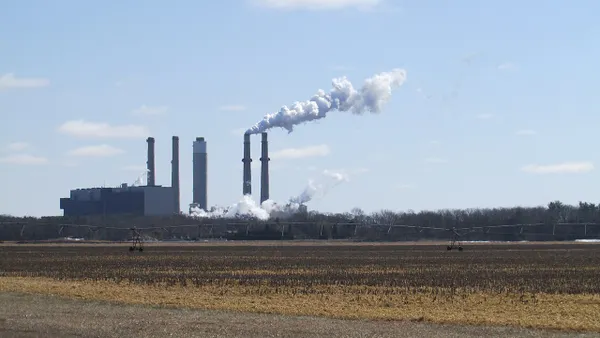New ways for utilities to use solar and other distributed energy resources to their advantage may soon emerge from the Department of Energy's SUNRISE program.
The $7.8 million Solar Utility Networks: Replicable Innovations in Solar Energy (SUNRISE) fund has a bigger goal than the many unique innovations coming out of DOE’s SunShot program: It wants breakthrough concepts that can be implemented at scale and replicated across the energy generation and delivery industries.
Rural electric co-ops
“Utility scale solar for utilities” is what the National Rural Electric Cooperative Association (NRECA) will be looking for as fifteen of its 900-plus national members use SUNRISE funding to build 21 megawatts of projects ranging from 250 kilowatts to one megawatt, explained Project Advisor Peter Muhoro.
The smaller utilities serve 42 million customers in 47 states and supply 12% of U.S. electricity. Their engineers “often wear about 55-and-a-half different hats,” Muhoro said, and have increasingly been asking NRECA for help integrating solar. “We were being asked to do one thing for one co-op, and another for another, and we started to ask if there could be a standardized process with a standardized design and a how-to manual.”
“They were also reaching out to us about financing,” added NRECA Solar Utility Network Deployment Acceleration (SUNDA) liaison team lead Deb Roepke.
Co-ops are not for-profit organizations and therefore cannot take advantage of the 30% investment tax credit that has boosted the larger solar markets, Roepke explained. For co-ops, building solar has typically meant finding a partner with a tax equity appetite.
“Part of this project will be looking at other business and finance models,” she said. “There is the tax equity model and the community solar model and we are asking if they can be combined. That could be a cheaper and more scalable and maintainable option.”
“I love the concept of community solar because it is community-owned and that is what a co-op is,” Muhoro added. “We have also had discussions with companies that do crowd-sourced funding. We want to look at different pathways so our members know their options.”
This is the first year for the four-year, three-phase, $4.8 million SUNDA project funded with a $3.6 million DOE SUNRISE grant and $1.2 million from the NRECA, its financial partners, and fifteen participating co-ops.
They have already developed a design for a one megawatt installation and a variety of business and financial models. The goal for phase one, Muhoro said, is a “field manual with technical designs and business models, and, potentially, a template that will allow a co-op to plug in some numbers and get some idea of where it is and what options it has.”
They are also working on group discount procurement deals through national and international module manufacturers, inverter vendors, and racking and mounting structure makers, Roepke added, and are very close to finalizing contracts.
Four co-ops are already in development: Anza Electric in California (one megawatt), CoServ Electric in Texas (one megawatt), Great River Energy in Minnesota (250 kilowatts), and Sussex Rural Electric in New Jersey (750 kilowatts)
“They are all so different we don’t have any generalizations yet,” Roepke said.
“One size will not fit all but this project should help our members get several steps ahead in the game, much farther than they would be alone,” Muhoro said.
DOE saw in NRECA’s proposal the possibility of a standardized, scalable package that could, Roepke said, “make it cheaper and easier for co-ops to evaluate and implement solar PV.”
Big distribution systems
PEPCO Holdings’ nearly $980,000 SUNRISE grant is to find new ways of controlling existing distribution system equipment to avoid the expensive upgrades some predict are unavoidable with increased levels of solar, explained project lead Steve Steffel, P.E., Pepco’s Distributed Energy Resource Planning and Analytics Manager.
The most important part of the two year project that runs through late 2015, according to Steffel, is the kind of generalizable and scalable solution targeted by SUNRISE. It is aimed at discovering (1) whether utilities will have central control through smart inverters and (2) what other operating procedures utilities can use on their distribution systems.
Acquiring data from the Pepco service territory is Steffel’s biggest challenge but that data will show ways to control voltage regulation and reactive compensation equipment that will allow the most PV without pushing voltage beyond system limits.
Steffel’s team is looking for "a strategy and general voltage philosophy" that will give distributed energy resources' voltage "head room." That can be achieved, he explained, by finding optimal settings for voltage regulators and smart inverters on feeder lines.
As a result, “voltage regulation equipment will provide higher voltages during higher load and low generation as well as lower voltages during lower load and higher generation.”
Pepco’s simulations will eventually, according to Steffel, reveal “cost effective ways to better control voltages so that we can provide voltage ‘head room’ to those customers with distributed generation that export and at times cause themselves elevated voltages.”
The project proposal predicts the extra “headroom” will add 10% to 15% more solar penetration capacity to big distribution systems like Pepco’s.






















